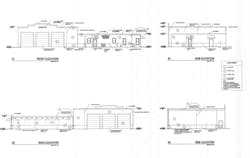When constructing or renovationg fire stations, the primary concern should be for the safety of the men and women who must call this place home for 24 hours at a time. Conducting a review for a fire station facility in my jurisdiction (Martin County, FL), brought several thoughts and code concerns to the forefront of my mind. Applicable codes for fire station facilities include NFPA 1 Uniform Fire Code, NFPA 1500 Standard on Fire Department Occupational Safety and Health Program, and NFPA 1581 Standard on Fire Department Infection Control Program.
NFPA 1:13.3.2.3 - New buildings housing emergency fire, rescue, or ambulance services shall be protected throughout by approved automatic sprinkler systems.
1500:9.1.3.1 - When activated, these detectors shall sound an alarm throughout the fire station. 1500:9.1.4 - All existing and new fire department facilities shall have carbon monoxide detectors installed in locations in sleeping and living areas, such that any source of carbon monoxide would be detected before endangering the members. Fire alarms in stations are required. 1500:9.1.6 - The fire department shall prevent exposure to fire fighters and contamination of living and sleeping areas to exhaust emissions.
About the Author

Aaron Johnson
Aaron Johnson has been in the fire service for over 11 years and currently serves as fire marshal for Rural/Metro Fire Dept. in south Florida. He can be contacted at his website www.thecodecoach.com.

